Five dollar silver certificates were produced from 1886 to 1953 and there were different series that were issued. Many of these silver certificates are renown for their unique designs. Keep reading below to see these designs and what the current values are for each series.
Large Bills
The earliest silver certificates were large notes. These notes are about 40% larger than the small notes that are currently in circulation. Generally these large notes are more rare and command a higher price.
1886 Series
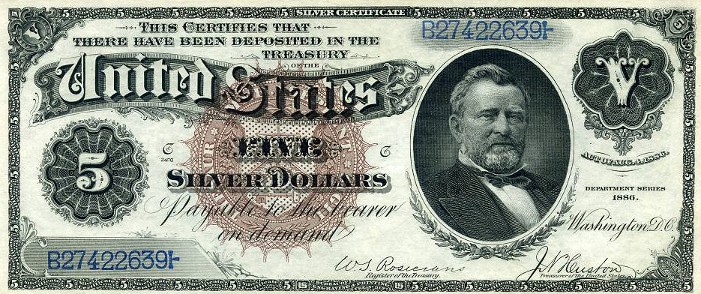
This was the first five dollar silver certificate issued and today these notes can be quite valuable.
It's nicknamed the 'Morgan Back' because the back of the bill displays several Morgan silver dollars. This design makes the bill appealing to both currency and coin collectors. It's believed that the coin images were printed on the back in order for people to feel comfortable using the silver certificate. Back then, coins were much more widely used than paper currency.
These bills are rare. There were millions printed, but there just aren't many known to be in existence today. Most of these bills are worth around $875 in very good condition. In very fine condition the value is around $2,250. In extremely fine condition the value is around $5,250. In uncirculated condition the price is around $11,000 for bills with an MS 63 grade. Bills with the Rosecrans and Nebecker signature variety with the small red seal are worth more money.
1891 Series
The 1891 series has the same front design as the 1886 series. However the back design is different. The 1891 back design is more plain looking and thus less appealing to collectors. The 1891 series is also much more common which also makes it less valuable. However it's still a nice bill to own and it's needed to complete the full silver certificate collection.
The 1891 series five dollar silver certificates are each worth around $400 in very good condition. In very fine condition the value is around $1,000. In extremely fine condition the value is around $2,500. In uncirculated condition the price is around $4,500 for bills with an MS 63 grade.
1896 Series
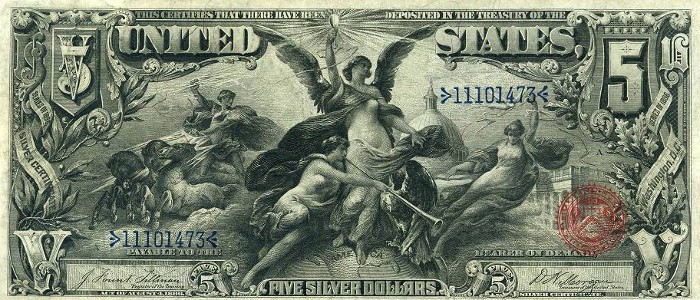
1896 silver certificates are known as the 'educational series'. This five dollar issue is nicknamed the 'five dollar ed' and it's the most popular note in the educational series.
Before 1896 silver certificates used to have a regular portrait on the front. But in 1896 the front design changed to real artwork.
On the front of this bill you can see an angel and a chariot in front of the United States Capital dome. It's widely regarded as one of the best currency designs ever. Take a look at the picture above to judge for yourself. The beautiful design makes these notes popular.
The 1896 series five dollar silver certificates are each worth around $850 in very good condition. In very fine condition the value is around $2,750. In extremely fine condition the value is around $7,000. In uncirculated condition the price is around $11,500 for bills with an MS 63 grade.
1899 Series
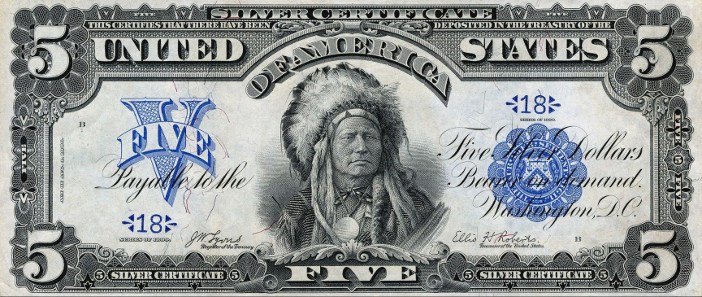
This is another popular silver certificate because of its unique design. Nicknamed 'The Chief', it's the only piece of United States paper currency that features a Native American. Pictured on the front is Chief Running Antelope.
There are eleven different signature combinations, but only the Napier Thompson signature combination is more valuable than the rest. In addition, low serial number bills are in existence and they will also command a premium.
Most 1899 series five dollar silver certificates are worth around $450 in very good condition. In very fine condition the value is around $900. In extremely fine condition the value is around $2,250. In uncirculated condition the price is around $4,500 for bills with an MS 63 grade.
1923 Series
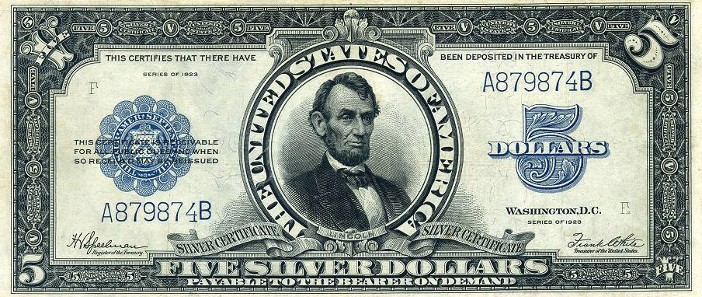
This is the first five dollar silver certificate series to feature Abraham Lincoln. It's also the only large five dollar large silver certificate to be printed in the 20th century.
It's nicknamed the 'Porthole' because Lincoln's portrait has a large frame which makes it appear that he is looking out of a ship's porthole.
There were over four million of these bills printed but there are only around 1,500 still in existence today. This makes them quite rare. Not many of them come up for sale and they are desired by both silver certificate collectors and Abraham Lincoln enthusiasts.
The 1923 series five dollar silver certificates are each worth around $450 in very good condition. In very fine condition the value is around $1,200. In extremely fine condition the value is around $2,750. In uncirculated condition the price is around $4,750 for bills with an MS 63 grade.
Small Bills
There were a few different small bill series issued. Generally these bills aren't as valuable as the large ones. On each small bill there is an inscription that reads "five dollars in silver payable to the bearer on demand".
1934 Series
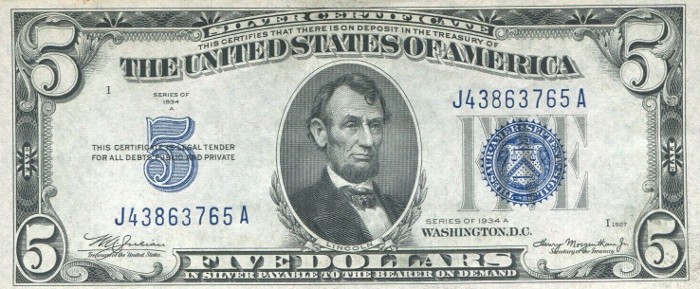
The 1934 five dollar silver certificates look like regular five dollar bills, except for a blue seal instead of a green seal. There were several different series for this year, and they include: 1934, 1934A, 1934B, 1934C, and 1934D. There is also the 1934A North Africa notes, which are more valuable than the others. Star notes are available and they are also more valuable.
The common 1934 five dollar silver certificates are not very valuable. In very fine condition the value is around $12.50-15. In uncirculated condition the price is around $45 for bills with an MS 63 grade.
Most 1934 five dollar silver certificate star notes are each worth around $55 in very fine condition. In uncirculated condition the price is around $250 for star notes with an MS 63 grade. The 1934 and 1934B series star notes are worth more.
The 1934A North Africa notes sell for around $95 in very fine condition. In uncirculated condition the price is around $300 for bills with an MS 63 grade.
The 1934A North Africa star notes sell for around $400 in very fine condition. In uncirculated condition the price is around $1,500 for star notes with an MS 63 grade.
1953 Series
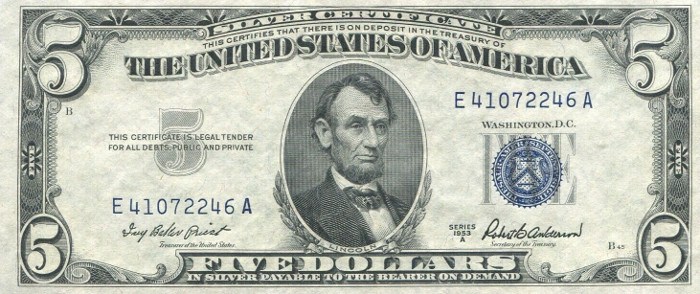
The 1953 five dollar silver certificates have almost the same look as the previous 1934 series. The difference is that the number five on the front left hand side of the bill is a light green color and the seal on the right side of the bill is smaller.
There were a few different series printed but none of them are valuable. These bills will each sell for around $12 in very good condition. In uncirculated condition the price is around $35 for bills with an MS 63 grade.
Most star notes are common and only sell for around $30 each in very fine condition and $95 in uncirculated condition with an MS 63 grade. The 1953B series star note is the exception as this bill will sell for more money.
Grading System
Very good- A circulated note that has considerable wear to it. There might be one or two tears on the edge of the note. The note may be discolored, dark in appearance, or limp.
Very fine- A note that has been in circulation but not for a long time. The note is still relatively crisp. There may be some creases, folds, or light smudges.
Extremely fine- A note that shows small signs of having been in circulation. The note will be bright and it will have almost all of its original crispness. There might be one or two minor creases or folds but there are no stains, discolorations, or tears.
MS 63 choice uncirculated- A note that shows no signs of ever having been in circulation. The note still has its original crispness. The note is also well-centered.
Conclusion
Five dollar silver certificates are great collectible items and the earlier series notes can be quite valuable. These bills feature some of the best designs ever printed on United States paper currency. The 1896 series and 1899 series are especially famous for their front designs.
If your bill is valuable then it's best to place it into a currency holder. There are both large-note currency holders and small-note currency holders available.
Sources:
A Guide Book of United States Paper Money
See also:
